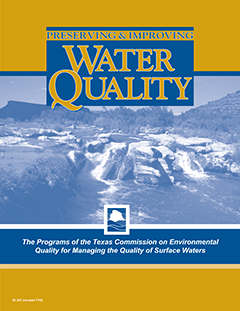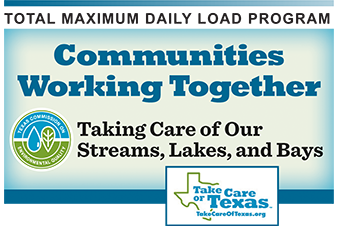TMDLs and Their Implementation


On this page:
- What the TMDL Program Does
- How TMDLs and Implementation Plans Are Developed
- Surface Water Quality: How It Is Measured
- Preserving and Improving Water Quality: Programs of the TCEQ
- Contact the TMDL Program
![]() Sign up for News Updates from the TMDL Program
Sign up for News Updates from the TMDL Program
What the TMDL Program Does
The TCEQ Total Maximum Daily Load (TMDL) Program works with communities to improve water quality in rivers, lakes, and estuaries in Texas.
TMDLs are developed for streams, lakes, and bays that are quality-limited due to a pollutant or adverse condition. A TMDL is like a budget for pollution — determining how much is too much of a particular pollutant. In other words, it estimates the amount (or load) of a pollutant that a body of water can assimilate and still support its designated uses.
Based on the environmental target in the TMDL, watershed stakeholders develop an implementation plan (I-Plan) to mitigate sources of pollution within the watershed and restore impaired uses. An I-Plan puts the TMDL into action by outlining the steps necessary to reduce pollutant loads through regulatory and voluntary activities.
The TCEQ TMDL program is authorized by and created to fulfill the requirements of Section 303(d) of the federal Clean Water Act and its implementing regulations.
For an overview of the TCEQ's approach to managing the quality of surface waters in Texas, see Preserving and Improving Water Quality.
How TMDLs and Implementation Plans Are Developed
TMDLs are developed by TCEQ personnel, cooperating state agencies, or independent contractors at the direction of the TCEQ. Occasionally, organizations develop TMDLs independently of TCEQ; these are referred to as “third-party” TMDLs. Ultimately, TCEQ is responsible for the adoption of all TMDLs in Texas and their subsequent approval by the U.S. Environmental Protection Agency.
Both a TMDL and its I-Plan are needed when a river, lake, or bay is water-quality limited due to a pollutant or adverse condition. TCEQ asks people who live in the watershed—the stakeholders—to assist in developing both documents. Often, work starts on the I-Plan and the TMDL at roughly the same time, since it can take a while to discuss all the options and for all the parties to agree on the best course of action.
Developing TMDLs
The development of TMDLs is a scientifically rigorous process of data collection and analysis. TCEQ asks stakeholders to share their knowledge about local conditions and help make decisions such as the best locations for collecting water samples. TCEQ engages other public or private organizations as needed to help with specific technical issues. TCEQ shares the status of TMDL development with stakeholders for feedback at key decision points in the allocation development.
Building an I-Plan
Communities must work together to develop I-Plans to improve water quality because ultimately, it is the people in the community who implement I-Plans to clean up their rivers, lakes, and bays.
To develop the I-Plan, stakeholders come together as a community to decide how to reach their goals. Usually, the stakeholders form a coordinating committee to develop the written plan. The coordinating committee guides stakeholders through public discussions about what is needed. The members also research options being considered and report back to the stakeholder group at large and to their communities.
Through the planning process, stakeholders decide how to share the load of reducing pollution, identify financial and technical resources needed or available to them, and looks for ways to get the resources they need.
The final I-Plan outlines:
- what the community will do over the next one to five years,
- who in the community will do it,
- when they will do it, and
- how they will gauge improvement.
For example:
- Wastewater treatment facilities may commit to reducing the amount of a pollutant in their discharges.
- Cities might work to control runoff from their streets through stormwater management.
- Farmers and ranchers might decide to use new or improved practices that make runoff water cleaner.
- Government agencies or educational institutions might help by providing educational and promotional materials.
After an I-Plan is developed, stakeholders meet periodically to measure their progress and to determine whether the plan needs to be revised. Success depends on everyone doing their part.
Learn more about what it means to participate in TMDL projects.
How Are TMDLs Funded?
The Texas Legislature appropriates funds to TCEQ and the Texas State Soil and Water Conservation Board to support the development and implementation of TMDLs. Both agencies also use federal money to support the program. Funding for implementation of regulatory control actions is frequently from local governments or privately-owned facilities that discharge wastewater.
Surface Water Quality: How It Is Measured
Standards Define Water Quality
To measure water quality, we must first define it. The Texas Surface Water Quality Standards are rules designed to:
- Designate the uses, or purposes, for which a water body should be suitable.
- Establish numerical and narrative goals for water quality throughout the state.
- Provide a basis on which TCEQ regulatory programs can establish reasonable methods to implement and attain the state’s goals for water quality.
Standards are protective; that is, they signal a possibility that water quality may be inadequate to attain designated uses.
The Texas Integrated Report of Surface Water Quality
The Texas Integrated Report of Surface Water Quality is a snapshot in time—an overview of the status of surface water quality throughout the state, including concerns for public health, fitness for aquatic species and other wildlife, and specific pollutants and their possible sources. The 303(d) List, a subset of the report, identifies waters that do not attain one or more standards for their use. Water bodies identified in Category 5a of the 303(d) List are those impaired waters for which the state plans to develop TMDLs. All impaired waters include those in Category 4 in addition to Category 5. Category 4 includes impaired waters for which TMDLs have already been adopted, or for which other management strategies are underway to improve water quality.
Read Texas Surface Water Quality: What Is It, and How Is It Measured? for a brief overview of water quality standards and the criteria by which surface water quality is evaluated.
Preserving and Improving Water Quality: Programs of the TCEQ
The publication Preserving and Improving Water Quality provides an overview of the way TCEQ evaluates the quality of surface waters in Texas, and the programs and practices the TCEQ employs to protect and restore surface water quality. You can order printed copies from our Publications section.
To contact us, please email tmdl@tceq.texas.gov or call 512-239-6682. We invite you to ![]() Sign up for News Updates from the TMDL Program.
Sign up for News Updates from the TMDL Program.




 Back to top
Back to top